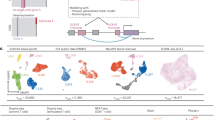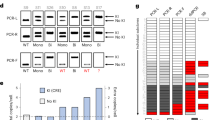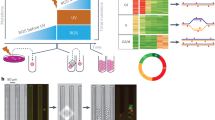Abstract
Defined transcription factors can induce epigenetic reprogramming of adult mammalian cells into induced pluripotent stem cells. Although DNA factors are integrated during some reprogramming methods, it is unknown whether the genome remains unchanged at the single nucleotide level. Here we show that 22 human induced pluripotent stem (hiPS) cell lines reprogrammed using five different methods each contained an average of five protein-coding point mutations in the regions sampled (an estimated six protein-coding point mutations per exome). The majority of these mutations were non-synonymous, nonsense or splice variants, and were enriched in genes mutated or having causative effects in cancers. At least half of these reprogramming-associated mutations pre-existed in fibroblast progenitors at low frequencies, whereas the rest occurred during or after reprogramming. Thus, hiPS cells acquire genetic modifications in addition to epigenetic modifications. Extensive genetic screening should become a standard procedure to ensure hiPS cell safety before clinical use.
This is a preview of subscription content, access via your institution
Access options
Subscribe to this journal
Receive 51 print issues and online access
$199.00 per year
only $3.90 per issue
Buy this article
- Purchase on Springer Link
- Instant access to full article PDF
Prices may be subject to local taxes which are calculated during checkout

Similar content being viewed by others
Accession codes
Primary accessions
Sequence Read Archive
Data deposits
Sequencing results for the mutations reported here are included in Supplementary Figure 1. Raw Illumina sequencing reads are available from the NCBI ShortRead Archive, accession SRP005709, except for lines derived from Hib11, Hib17, Hib29, CF, HFFxF, dH1F fibroblasts as the original donors were not consulted about public release of their genome data.
References
Takahashi, K. & Yamanaka, S. Induction of pluripotent stem cells from mouse embryonic and adult fibroblast cultures by defined factors. Cell 126, 663–676 (2006)
Yu, J. et al. Induced pluripotent stem cell lines derived from human somatic cells. Science 318, 1917–1920 (2007)
Mayshar, Y. et al. Identification and classification of chromosomal aberrations in human induced pluripotent stem cells. Cell Stem Cell 7, 521–531 (2010)
Hong, H. et al. Suppression of induced pluripotent stem cell generation by the p53–p21 pathway. Nature 460, 1132–1135 (2009)
Li, H. et al. The Ink4/Arf locus is a barrier for iPS cell reprogramming. Nature 460, 1136–1139 (2009)
Kawamura, T. et al. Linking the p53 tumour suppressor pathway to somatic cell reprogramming. Nature 460, 1140–1144 (2009)
Utikal, J. et al. Immortalization eliminates a roadblock during cellular reprogramming into iPS cells. Nature 460, 1145–1148 (2009)
Marión, R. M. et al. A p53-mediated DNA damage response limits reprogramming to ensure iPS cell genomic integrity. Nature 460, 1149–1153 (2009)
Ruiz, S. et al. A high proliferation rate is required for somatic cell reprogramming and maintenance of human embryonic stem cell identity. Curr. Biol. 21, 45–52 (2011)
Porreca, G. J. et al. Multiplex amplification of large sets of human exons. Nature Methods 4, 931–936 (2007)
Deng, J. et al. Targeted bisulfite sequencing reveals changes in DNA methylation associated with nuclear reprogramming. Nature Biotechnol. 27, 353–360 (2009)
Bashiardes, S. et al. Direct genomic selection. Nature Methods 2, 63–69 (2005)
Gnirke, A. et al. Solution hybrid selection with ultra-long oligonucleotides for massively parallel targeted sequencing. Nature Biotechnol. 27, 182–189 (2009)
Levy, S. et al. The diploid genome sequence of an individual human. PLoS Biol. 5, e254 (2007)
Drmanac, R. et al. Human genome sequencing using unchained base reads on self-assembling DNA nanoarrays. Science 327, 78–81 (2009)
Ng, S. B. et al. Targeted capture and massively parallel sequencing of 12 human exomes. Nature 461, 272–276 (2009)
Kumar, P., Henikoff, S. & Ng, P. C. Predicting the effects of coding non-synonymous variants on protein function using the SIFT algorithm. Nature Protocols 4, 1073–1081 (2009)
Forbes, S. A. et al. The Catalogue of Somatic Mutations in Cancer (COSMIC). Curr. Protocols Hum. Genet. 10, 10.11 (2008)
Shah, S. P. et al. Mutational evolution in a lobular breast tumour profiled at single nucleotide resolution. Nature 461, 809–813 (2009)
Futreal, P. A. et al. A census of human cancer genes. Nature Rev. Cancer 4, 177–183 (2004)
Hamosh, A., Scott, A. F., Amberger, J. S., Bocchini, C. A. & McKusick, V. A. Online Mendelian Inheritance in Man (OMIM), a knowledgebase of human genes and genetic disorders. Nucleic Acids Res. 33, D514–D517 (2005)
Druley, T. E. et al. Quantification of rare allelic variants from pooled genomic DNA. Nature Methods 6, 263–265 (2009)
Ahuja, D., Saenz-Robles, M. T. & Pipas, J. M. SV40 large T antigen targets multiple cellular pathways to elicit cellular transformation. Oncogene 24, 7729–7745 (2005)
Yu, J. et al. Human induced pluripotent stem cells free of vector and transgene sequences. Science 324, 797–801 (2009)
Pleasance, E. D. et al. A comprehensive catalogue of somatic mutations from a human cancer genome. Nature 463, 191–196 (2010)
Lee, W. et al. The mutation spectrum revealed by paired genome sequences from a lung cancer patient. Nature 465, 473–477 (2010)
Ding, L. et al. Genome remodelling in a basal-like breast cancer metastasis and xenograft. Nature 464, 999–1005 (2010)
Dennis, G., Jr et al. DAVID: Database for Annotation, Visualization, and Integrated Discovery. Genome Biol. 4, P3 (2003)
Lee, J. H. et al. A robust approach to identifying tissue-specific gene expression regulatory variants using personalized human induced pluripotent stem cells. PLoS Genet. 5, e1000718 (2009)
Park, I. H. et al. Reprogramming of human somatic cells to pluripotency with defined factors. Nature 451, 141–146 (2008)
Chan, E. M. et al. Live cell imaging distinguishes bona fide human iPS cells from partially reprogrammed cells. Nature Biotechnol. 27, 1033–1037 (2009)
Dimos, J. T. et al. Induced pluripotent stem cells generated from patients with ALS can be differentiated into motor neurons. Science 321, 1218–1221 (2008)
Rodriguez-Piza, I. et al. Reprogramming of human fibroblasts to induced pluripotent stem cells under xeno-free conditions. Stem Cells 28, 36–44 (2010)
Aasen, T. et al. Efficient and rapid generation of induced pluripotent stem cells from human keratinocytes. Nature Biotechnol. 26, 1276–1284 (2008)
Stewart, S. A. et al. Lentivirus-delivered stable gene silencing by RNAi in primary cells. RNA 9, 493–501 (2003)
Warren, L. et al. Highly efficient reprogramming to pluripotency and directed differentiation of human cells with synthetic modified mRNA. Cell Stem Cell 7, 618–630 (2010)
Akagi, T., Sasai, K. & Hanafusa, H. Refractory nature of normal human diploid fibroblasts with respect to oncogene-mediated transformation. Proc. Natl Acad. Sci. USA 100, 13567–13572 (2003)
Cowan, C. A. et al. Derivation of embryonic stem-cell lines from human blastocysts. N. Engl. J. Med. 350, 1353–1356 (2004)
Boulting, G. L. et al. A functionally characterized test set of human induced pluripotent stem cells. Nature advance online publication. 10.1038/nbt.1783 (3 February 2011)
Zhang, K. et al. Digital RNA allelotyping reveals tissue-specific and allele-specific gene expression in human. Nature Methods 6, 613–618 (2009)
Meena Kishore, S., Vincent, T. K. C. & Pandjassarame, K. Distributions of exons and introns in the human genome. In Silico Biol. 4, 387–393 (2004)
Acknowledgements
We thank J. M. Akey, G. M. Church, S. Ding, J. B. Li and J. Shendure for discussions and suggestions, S. Vassallo for assistance with DNA shearing, and G. L. Boulting and S. Ratansirintrawoot for assistance with hiPS cell culture. This study is supported by NIH R01 HL094963 and a UCSD new faculty start-up fund (to K.Z.), a training grant from the California Institute for Regenerative Medicine (TG2-01154) and a CIRM grant (RC1-00116) (to L.S.B.G.). L.S.B.G. is an Investigator of the Howard Hughes Medical Institute. A. Gore is supported by the Focht-Powell Fellowship and a CIRM predoctoral fellowship. M.L.W. is supported by an institutional training grant from the National Institute of General Medical Sciences (T32 GM008666). Y.-H.L. is supported by the A*Star Institute of Medical Biology and the Singapore Stem Cell Consortium. Work in the laboratory of J.C.I.B. was supported by grants from MICINN, Sanofi-Aventis, the G. Harold and Leila Y. Mathers Foundation and the Cellex Foundation. G.Q.D. is an investigator of the Howard Hughes Medical Institute and supported by grants from the NIH.
Author information
Authors and Affiliations
Contributions
L.S.B.G. and K.Z. co-directed the study. A. Gore, Z.L., L.S.B.G. and K.Z. designed the experiments. J.E.Y., S.A., J.A.-B., I.C., A. Giorgetti, M.A.I., E.K., J.-H.L., Y.-H.L., P.D.M., N.M., A.D.P., S.R., M.L.W., J. Yu, J.C.I.B., D.J.R., J.A.T., K.E., G.Q.D. and L.S.B.G. biopsied, cultured and derived hiPS cell lines. Z.L. performed DNA extraction. A. Gore, Z.L. and K.Z. performed exome library construction, DigiQ library construction and validation Sanger sequencing. H.-L.F. performed Illumina sequencing. A. Gore and K.Z. performed bioinformatic and statistical analysis with contributions from E.F.K. A. Gore, Z.L., L.S.B.G., G.Q.D. and K.Z. wrote the manuscript with contributions from all other authors.
Corresponding authors
Ethics declarations
Competing interests
The authors declare no competing financial interests.
Supplementary information
Supplementary Information
The file contains Supplementary Figures 1-5 with legends and a Supplementary Note. (PDF 8937 kb)
Supplementary Tables
The file contains Supplementary Tables 1-3 (XLS 73 kb)
PowerPoint slides
Rights and permissions
About this article
Cite this article
Gore, A., Li, Z., Fung, HL. et al. Somatic coding mutations in human induced pluripotent stem cells. Nature 471, 63–67 (2011). https://doi.org/10.1038/nature09805
Received:
Accepted:
Published:
Issue Date:
DOI: https://doi.org/10.1038/nature09805
This article is cited by
-
High prevalence of acquired cancer-related mutations in 146 human pluripotent stem cell lines and their differentiated derivatives
Nature Biotechnology (2024)
-
Integrated transcriptome landscape of ALS identifies genome instability linked to TDP-43 pathology
Nature Communications (2023)
-
Minimal residual disease in solid tumors: an overview
Frontiers of Medicine (2023)
-
Building gut from scratch — progress and update of intestinal tissue engineering
Nature Reviews Gastroenterology & Hepatology (2022)
Comments
By submitting a comment you agree to abide by our Terms and Community Guidelines. If you find something abusive or that does not comply with our terms or guidelines please flag it as inappropriate.



